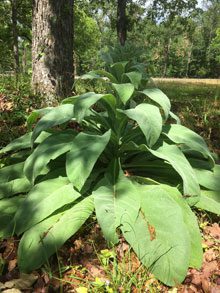 At various points during the year, I can predict with some certainty that a flurry of questions will come my way about some particularly unusual flower or a striking plant that the questioner must find out what it is. The questions often come from visitors to the area, but not infrequently it is locals who have only recently determined to find out what this plant is, perhaps something they’ve only recently noticed.
At various points during the year, I can predict with some certainty that a flurry of questions will come my way about some particularly unusual flower or a striking plant that the questioner must find out what it is. The questions often come from visitors to the area, but not infrequently it is locals who have only recently determined to find out what this plant is, perhaps something they’ve only recently noticed.
In the fall, as the summer boats from Bar Harbor and New Haven make their annual voyage to cold-weather ports south, following the Intracoastal Waterway, sailors are astounded by great billowing mounds of fluffy white against silvery-gray foliage along the banks of the waterway. It’s always satisfying to be able to tell them that it is Baccharis halimifolia, often called salt-bush or groundsel bush. It certainly is handsome enough to ask about, and I understand some nurseries are now selling it for landscaping.
In early summer, along roadsides in rural areas of the state, many people notice the tall spikes, bare of leaves but covered in orange-gold flowers in single file up the stem. They usually recognize the form as very like the garden gladiolus, but it is out of place in the roadside and not as showy as those flouncy blooms of gardens and funerals. I’m happy to let anyone who inquires know that it is, indeed, a gladiolus – Gladiolus dalenii – a species originally from southern Africa and now spread across the world, carried by gardeners who appreciate its striking beauty.
Beginning in summer, open fields often have great clumps of a tall-growing, feathery plant in a rich green color. It’s an eye-catching plant, and an observant plant person will sometimes notice that as the season progresses some of the six or eight foot tall stems will develop a flattened, contorted growth. Once winter kills the summer growth, these stems remain, twisted, brown, intriguing. Perfect for interesting flower arrangements. This is dog fennel, I am happy to inform the inquisitive plant seeker, Eupatorium capillifolium, and the flattened upper stems on some of the plants is a somewhat rare condition called Fasciation. The specific cause for this growth pattern is not known; it is sometimes genetic, sometimes viral or bacterial in origin. But it certainly makes for a fascinatingplant!
All of which would explain why I’m hardly surprised to be asked several time in the last week or two about a vey unusual silvery plant with huge leaves growing close to the ground. If the questioner has been able to get a closer look, they may point out that the giant leaves are covered with silky hairs. And if she has been lucky enough to observe this spectacular plant over several weeks, she will point out that it seems to be growing upward ‘like a beanstalk’ (a stalk, not a vine).
This is Verbascum thapsus, native to Europe and the Mediterranean area. Because of its appearance, it has acquired popular names like flannel-leaf, torch plant, velvet plant. Most commonly, it is known as mullein.
Both in its native lands and in North America the plant has been used in numerous ways in various cultures. I’m no expert in folk medicines and edible qualities of wild plants, so I’ll avoid suggesting any such uses for mullein. You may want to look up mullein to see how people have made use of the plant over the centuries.
Mullein is a biennial plant; that is, its first year of growth is low to the ground and involves substantial root development below. After dying back in winter, spring growth first makes for the rosette of fuzzy silver leaves that make such an impression. Surprisingly quickly, the rosette begins to elongate, to stretch toward the sky,  reaching eventually four or five feet in height. The lower stem tapers from the large leaves to smaller, then becomes bare. Finally, the upper foot or two of the stem develops small yellow flowers in one or more vertical spikes.
reaching eventually four or five feet in height. The lower stem tapers from the large leaves to smaller, then becomes bare. Finally, the upper foot or two of the stem develops small yellow flowers in one or more vertical spikes.
The mullein in bloom attracts bees and all sorts of other pollinators, which help the plant set seeds along the tall spike. This is fortunate, since the plant will die at the end of this second year, its bloom the way for it to send dozens or hundreds of new plants to take root all around.
Verbascum is a genus with a number of species. Lately, several spectacular cultivars have appeared in the trade, and they’re worth trying in the garden. “Southern Charm” blooms in a range of soft, rich colors, and it produces multiple spikes on a single main stem. “Sugar Plum” and “Sixteen Candles” are two of the other varieties available.
While the domesticated varieties may win the battle for beautiful flowers, the good old Great Mullein of fields and roadsides still commands awe and curiosity. And now you can tell a curious observer just what that plant is!
NB: the first image is by the author; the second is from Bluestone Per







